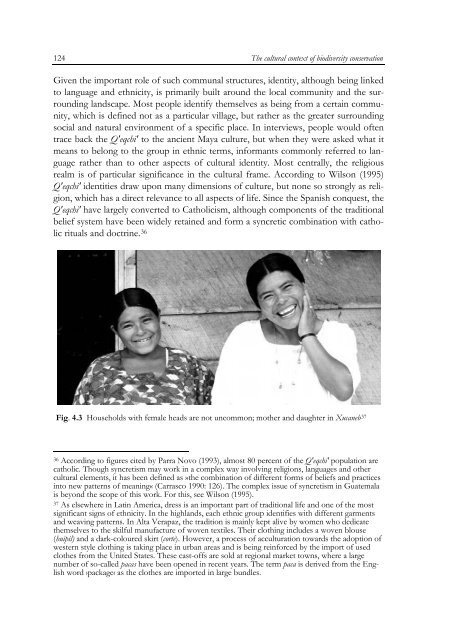The cultural context of biodiversity conservation - Oapen
The cultural context of biodiversity conservation - Oapen
The cultural context of biodiversity conservation - Oapen
Create successful ePaper yourself
Turn your PDF publications into a flip-book with our unique Google optimized e-Paper software.
124<br />
<strong>The</strong> <strong>cultural</strong> <strong>context</strong> <strong>of</strong> <strong>biodiversity</strong> <strong>conservation</strong><br />
Given the important role <strong>of</strong> such communal structures, identity, although being linked<br />
to language and ethnicity, is primarily built around the local community and the surrounding<br />
landscape. Most people identify themselves as being from a certain community,<br />
which is defined not as a particular village, but rather as the greater surrounding<br />
social and natural environment <strong>of</strong> a specific place. In interviews, people would <strong>of</strong>ten<br />
trace back the Q'eqchi' to the ancient Maya culture, but when they were asked what it<br />
means to belong to the group in ethnic terms, informants commonly referred to language<br />
rather than to other aspects <strong>of</strong> <strong>cultural</strong> identity. Most centrally, the religious<br />
realm is <strong>of</strong> particular significance in the <strong>cultural</strong> frame. According to Wilson (1995)<br />
Q'eqchi' identities draw upon many dimensions <strong>of</strong> culture, but none so strongly as religion,<br />
which has a direct relevance to all aspects <strong>of</strong> life. Since the Spanish conquest, the<br />
Q'eqchi' have largely converted to Catholicism, although components <strong>of</strong> the traditional<br />
belief system have been widely retained and form a syncretic combination with catholic<br />
rituals and doctrine. 36<br />
Fig. 4.3 Households with female heads are not uncommon; mother and daughter in Xucaneb 37<br />
36 According to figures cited by Parra Novo (1993), almost 80 percent <strong>of</strong> the Q'eqchi' population are<br />
catholic. Though syncretism may work in a complex way involving religions, languages and other<br />
<strong>cultural</strong> elements, it has been defined as »the combination <strong>of</strong> different forms <strong>of</strong> beliefs and practices<br />
into new patterns <strong>of</strong> meaning« (Carrasco 1990: 126). <strong>The</strong> complex issue <strong>of</strong> syncretism in Guatemala<br />
is beyond the scope <strong>of</strong> this work. For this, see Wilson (1995).<br />
37 As elsewhere in Latin America, dress is an important part <strong>of</strong> traditional life and one <strong>of</strong> the most<br />
significant signs <strong>of</strong> ethnicity. In the highlands, each ethnic group identifies with different garments<br />
and weaving patterns. In Alta Verapaz, the tradition is mainly kept alive by women who dedicate<br />
themselves to the skilful manufacture <strong>of</strong> woven textiles. <strong>The</strong>ir clothing includes a woven blouse<br />
(huipil) and a dark-coloured skirt (corte). However, a process <strong>of</strong> acculturation towards the adoption <strong>of</strong><br />
western style clothing is taking place in urban areas and is being reinforced by the import <strong>of</strong> used<br />
clothes from the United States. <strong>The</strong>se cast-<strong>of</strong>fs are sold at regional market towns, where a large<br />
number <strong>of</strong> so-called pacas have been opened in recent years. <strong>The</strong> term paca is derived from the English<br />
word ›package‹ as the clothes are imported in large bundles.

















